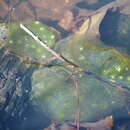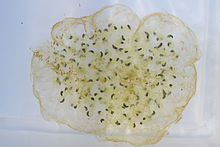pt-BR
nomes no trilho de navegação


Chlorococcum amblystomatis, synonym Oophila amblystomatis,[1] commonly known as chlamydomonad algae or salamander algae, is a species of single-celled green algae. When placed in the genus Oophila, it was the only species.[2] The Latin specific name amblystomatis means "loves salamander eggs". It does not occur anywhere in nature other than in the eggs of the spotted salamander, Ambystoma maculatum. The alga can invade and grow in the amphibian's egg capsule. Once inside, it metabolizes the carbon dioxide produced by the embryo and provides it with oxygen and sugar as a result of photosynthesis. This is an example of symbiosis,[3] and the only known example of an intracellular endosymbiont microbe in vertebrates.[4][5]
This symbiosis between Chlorococcum amblystomatis and the salamander may exist beyond the oocyte and early embryonic stage. Chlorophyll autofluorescence observation and ribosomal DNA analysis suggest that this algal species has invaded embryonic salamander tissues and cells during development and may even be transmitted to the next generation.[6]
Chlorococcum amblystomatis are only found in freshwater in woodland ponds. They grow best at a water depth of 30 cm (12 in) with the water temperature being 15 °C (59 °F) and an air temperature of 14 °C (57 °F). Their optimal pH tolerance ranges from 6.26 to 6.46 and they require an environment where there is 12 hours of sunlight and 12 hours of darkness. Cells are motile are able to move the water by the use of a flagellum. Oophila amblystomatis can also reproduce sexually and asexually. 16S rRNA has been partially sequenced as well as the 18S rRNA for the plasmid, however whole genome sequencing has not been done.[7]
 Ambystoma maculatum clear egg mass with green color from algae
Ambystoma maculatum clear egg mass with green color from algae Chlorococcum amblystomatis, synonym Oophila amblystomatis, commonly known as chlamydomonad algae or salamander algae, is a species of single-celled green algae. When placed in the genus Oophila, it was the only species. The Latin specific name amblystomatis means "loves salamander eggs". It does not occur anywhere in nature other than in the eggs of the spotted salamander, Ambystoma maculatum. The alga can invade and grow in the amphibian's egg capsule. Once inside, it metabolizes the carbon dioxide produced by the embryo and provides it with oxygen and sugar as a result of photosynthesis. This is an example of symbiosis, and the only known example of an intracellular endosymbiont microbe in vertebrates.
This symbiosis between Chlorococcum amblystomatis and the salamander may exist beyond the oocyte and early embryonic stage. Chlorophyll autofluorescence observation and ribosomal DNA analysis suggest that this algal species has invaded embryonic salamander tissues and cells during development and may even be transmitted to the next generation.
Chlorococcum amblystomatis are only found in freshwater in woodland ponds. They grow best at a water depth of 30 cm (12 in) with the water temperature being 15 °C (59 °F) and an air temperature of 14 °C (57 °F). Their optimal pH tolerance ranges from 6.26 to 6.46 and they require an environment where there is 12 hours of sunlight and 12 hours of darkness. Cells are motile are able to move the water by the use of a flagellum. Oophila amblystomatis can also reproduce sexually and asexually. 16S rRNA has been partially sequenced as well as the 18S rRNA for the plasmid, however whole genome sequencing has not been done.
Oophila amblystomatis est une espèce d’algues vertes de la famille des Chlorococcaceae.
Cette espèce et une espèce de salamandre, la Salamandre maculée, ont fait l’objet d'une étude par l’université canadienne d’Halifax qui met en lumière une symbiose entre le monde végétal et le monde animal. En effet, l’algue verte Oophila amblystomatis[1] colonise les embryons de salamandre et permet des échanges oxygène/azote qui contribuent à améliorer la croissance des embryons[2].
Ce qui rend unique l’endosymbiose avec la Salamandre maculée, c’est que cette dernière est un vertébré. Les vertébrés possèdent un système immunitaire qui élimine généralement tous corps étrangers. Pour déjouer cette barrière, Oophila amblystomatis s'introduit dans l'embryon de la Salamandre maculée avant que le système immunitaire de celle-ci ne soit mis en place. Des traces d’Oophila amblystomatis ont été détectées dans le système reproducteur de la salamandre et dans les œufs à des stades très précoces[1].
Oophila amblystomatis est une espèce d’algues vertes de la famille des Chlorococcaceae.
Oophila amblystomatis Lambert ex Printz, 1927[1], nota anche come alga della salamandra, è un'alga monocellulare, che vive in simbiosi con le uova delle salamandre del genere Ambystoma; l'alga, tramite la fotosintesi, aumenta l'ossigeno nell'uovo della salmandra. Questa alga trasmette i suoi geni inserendoli all'interno del girino.[2]
Oophila amblystomatis Lambert ex Printz, 1927, nota anche come alga della salamandra, è un'alga monocellulare, che vive in simbiosi con le uova delle salamandre del genere Ambystoma; l'alga, tramite la fotosintesi, aumenta l'ossigeno nell'uovo della salmandra. Questa alga trasmette i suoi geni inserendoli all'interno del girino.
Oophila amblystomatis, (em latim: "gosta de ovos de salamandra")[2] é uma espécie de alga unicelular. Não ocorre em mais lado nenhum da natureza a não ser nos ovos de alguns anfíbios, tais como os de Ambystoma maculatum. A alga pode invadir e crescer dentre do muco do ovo. Uma vez lá dentro, metaboliza o dióxido de carbono produzido pelo embrião e fornece-lhe oxigénio. É um exemplo de simbiose.[2] Um estudo por Ryan Kerney, da Universidade de Dalhousie, revelou que as células penetram nas células da salamandra. É o primeiro caso descrito de um organismo fotossintético a viver dentro de células de um vertebrado.[3]
|acessodata= (ajuda) Oophila amblystomatis, (em latim: "gosta de ovos de salamandra") é uma espécie de alga unicelular. Não ocorre em mais lado nenhum da natureza a não ser nos ovos de alguns anfíbios, tais como os de Ambystoma maculatum. A alga pode invadir e crescer dentre do muco do ovo. Uma vez lá dentro, metaboliza o dióxido de carbono produzido pelo embrião e fornece-lhe oxigénio. É um exemplo de simbiose. Um estudo por Ryan Kerney, da Universidade de Dalhousie, revelou que as células penetram nas células da salamandra. É o primeiro caso descrito de um organismo fotossintético a viver dentro de células de um vertebrado.